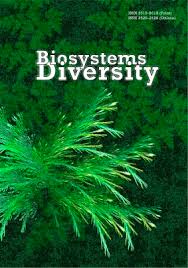Carbon dioxide emission and humus status of Albic Stagnic Luvisol under different fertilization regimes
Carbon dioxide emission and humus status of Albic Stagnic Luvisol under different fertilization regimes
Author(s): Y. M. Olifir, A. J. Habryiel, T. V. Partyka, O. S. HavryshkoSubject(s): Agriculture, Energy and Environmental Studies
Published by: Дніпропетровський національний університет імені Олеся Гончара
Keywords: mineral fertilizers; liming; soil acidity; soil buffering capacity; CO2; crop rotation productivity;
Summary/Abstract: The increase in the carbon dioxide content in the atmosphere, which enhances the greenhouse effect and leads to climate change, is the fundamental scientific problem of nowadays. Modern approaches to fertility management technologies of acid soils based on the principles of resource conservation and environmental safety are presented. They are based on the results of the study of carbon dioxide emission intensity, humus status, and crop rotation productivity in a classic long-term agricultural experiment under the influence of long-term use of various fertilizer systems with the application of ameliorant doses calculated by pH buffering capacity and hydrolytic acidity. The organo-mineral fertilizer system with the addition of 10 t of manure per ha of crop rotation area + N65P68K68, liming with a CaCO3 dose calculated according to pH buffering capacity (2.5 t/ha) contributes most to the optimization of soil processes. At the same time, it ensures the rational use of fertilizers and ameliorants, preservation of fertility, optimizes the processes of humus formation and carbon dioxide release. A high level of productivity of Albic Stagnic Luvisols forms under these conditions – 7.38 t/ha of grain units. Application of 1.0 and 1.5 lime norms calculated according to soil hydrolytic acidity with organic-mineral and mineral fertilizer systems on Albic Stagnic Luvisols in a short four-field crop rotation is not only a high-cost measure. However, it causes significant carbon loss in the form of CO2 due to additional mineralization. It is accompanied by calcium leaching and creates environmental problems in the conditions of the periodic washing-off water regime. Therefore, liming by CaCO3 dose calculated according to acid-base buffering capacity should be carried out before each of the following rotations in order to harmonize the environmental and productive functions of Albic Stagnic Luvisols in the short crop rotation. The obtained research results will be used to improve the methodology for determining carbon dioxide emissions and predicting the effect of various fertilizer and liming systems on its balance in the soil.
Journal: Biosystems Diversity
- Issue Year: 28/2020
- Issue No: 3
- Page Range: 320-328
- Page Count: 9
- Language: English

